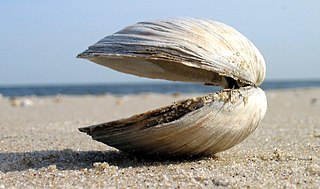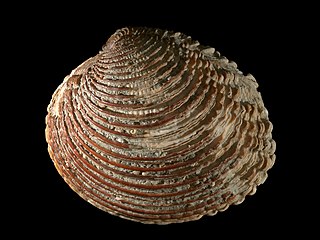
Extinction is the termination of a taxon by the death of its last member. A taxon may become functionally extinct before the death of its last member if it loses the capacity to reproduce and recover. Because a species' potential range may be very large, determining this moment is difficult, and is usually done retrospectively. This difficulty leads to phenomena such as Lazarus taxa, where a species presumed extinct abruptly "reappears" after a period of apparent absence.

Clam is a common name for several kinds of bivalve molluscs. The word is often applied only to those that are edible and live as infauna, spending most of their lives halfway buried in the sand of the seafloor or riverbeds. Clams have two shells of equal size connected by two adductor muscles and have a powerful burrowing foot. They live in both freshwater and marine environments; in salt water they prefer to burrow down into the mud and the turbidity of the water required varies with species and location; the greatest diversity of these is in North America.

Ignaz Edler von Born, also known as Ignatius von Born, was a mineralogist and metallurgist. He was a prominent freemason, being head of Vienna's lodge and an influential anti-clerical writer. He was the leading scientist in the Holy Roman Empire during the 1770s in the age of Enlightenment.

The Veneridae or venerids, common name: Venus clams, are a very large family of minute to large, saltwater clams, marine bivalve molluscs. Over 500 living species of venerid bivalves are known, most of which are edible, and many of which are exploited as food sources.

Build to order (BTO) is a real estate development scheme enacted by the Housing and Development Board (HDB), a statutory board responsible for Singapore's public housing. First introduced in 2001, it consists of a flat allocation system that offers flexibility in timing and location for owners buying new public housing residences in the country.

Poromyidae is a family of saltwater clams, marine bivalve molluscs in the order Anomalodesmata. The genus Dilemma, described in 2008, is remarkable for being a predator of copepods, which is very unusual for a sessile mollusc.

Hydroidolina is a subclass of Hydrozoa and makes up 90% of the class. Controversy surrounds who the sister groups of Hydroidolina are, but research has shown that three orders remain consistent as direct relatives: Siphonophorae, Anthoathecata, and Leptothecata.
A species (pl. species) in biology is often defined as the largest group of organisms in which any two individuals of the appropriate sexes or mating types can produce fertile offspring, typically by sexual reproduction. It is the basic unit of classification and a taxonomic rank of an organism, as well as a unit of biodiversity. Other ways of defining species include their karyotype, DNA sequence, morphology, behaviour, or ecological niche. In addition, paleontologists use the concept of the chronospecies since fossil reproduction cannot be examined.

Tivela is a genus of saltwater clams, marine bivalve molluscs in the subfamily Meretricinae of the family Veneridae, the Venus clams.

Tivela stultorum, also known as the Pismo clam, is a species of large, edible, saltwater clam, a marine bivalve mollusk in the family Veneridae, the Venus clams. This species is native to the eastern Pacific Ocean. As the name implies, the Pismo clam lives in Pismo Beach, California. It has been found at least as far south as 300 miles south of the US–Mexico border in Baja California on the Pacific Ocean side, where strong surf sometimes washes ashore live clams. The indigenous peoples of California used this species for food.

Donax hanleyanus, common name the wedge clam, is a marine bivalve mollusk species in the family Donacidae, the bean clams or wedge shells. It is widely distributed throughout the sandy beaches of the Atlantic coast of South America, from Brazil to Argentina.

Hinge teeth are part of the anatomical structure of the inner surface of a bivalve shell, i.e. the shell of a bivalve mollusk. Bivalves by definition have two valves, which are joined together by a strong and flexible ligament situated on the hinge line at the dorsal edge of the shell. In life, the shell needs to be able to open slightly to allow the foot and siphons to protrude, and then close again, without the valves moving out of alignment with one another. To make this possible, in most cases the two valves are articulated using an arrangement of structures known as hinge teeth. Like the ligament, the hinge teeth are also situated along the hinge line of the shell, in most cases.

Walter Narchi was a Brazilian marine biologist. He mainly researched the anatomy of bivalvia and from 1960 to 2004 wrote over 60 papers, some with original descriptions of new species of this class.
Ortoire, in Trinidad, is the archaeological type site for the Ortoiroid people, immigrants to the Antilles around 2000 BCE.












